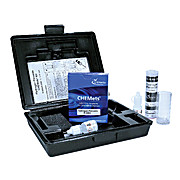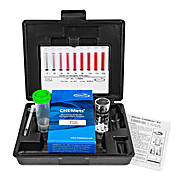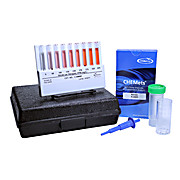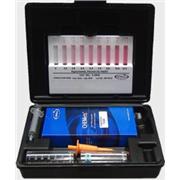CHEMetrics Water Quality
-
Formaldehyde CHEMets Kit
CHEMetricsFormaldehyde, a toxic substance, is used in the following applications: metal plating baths, textile treatments, biological specimen preservatives, and disinfectants of medical equipment. Commercial formaldehyde gas is readily soluble in water. The Purpald Method Reference:…
-
Nitrite VACUettes Kit, Range: 0-300 ppm as N
CHEMetricsNitrite, an intermediate in the nitrogen cycle, is formed during the decomposition of organic matter but readily oxidies to form nitrate. These processes occur in wastewater treatment plants, water distribution systems, and natural waters. Nitrites are useful as corrosion inhibitors,…
-
Sulfite (free) Titrets® Titration Cells
CHEMetricsSulfite is not usually present in surface waters. If sulfite is discharged in effluents or from domestic wastewaters, it readily oxidizes to form sulfate. Sodium sulfite is the most common form of sulfite and is an excellent reducing agent with applications as an oxygen scavenger. Sulfite…
-
Nitrite Vacu-vials Kit
CHEMetricsNitrite, an intermediate in the nitrogen cycle, is formed during the decomposition of organic matter but readily oxidizes to form nitrate. These processes occur in wastewater treatment plants, water distribution systems, and natural waters. Nitrites are useful as corrosion inhibitors,…
-
Iron CHEMets Kit
CHEMetricsIron is present in nature in the form of its oxides, or in combination with silicon or sulfur. The soluble iron content of surface waters rarely exceeds 1 mg/L, while ground waters often contain higher concentrations. The National Secondary Drinking Water Standard for iron is 0.3 mg/L, as iron…
-
Chloride Titrets® Test Kits
CHEMetricsChloride is the most common inorganic anion found in water and wastewater. The Maximum Secondary Contaminant Level for drinking water for chloride is 250 mg/L. Natural sources of salt are the ocean and various salt deposits above and below ground. Chloride is very corrosive to most metals in…
-
Phosphate Vacu-vials® Kits
CHEMetricsPhosphorus occurs naturally in rock formations in the earth's crust, usually as phosphate. High phosphate concentrations in surface waters may indicate fertilizer runoff, domestic waste discharge, or the presence of industrial effluents or detergents. Although phosphates from these sources are…
-
Molybdate Vacu-vials Kit
CHEMetricsMolybdate is used throughout the industrial water treatment and power generation industries as a corrosion inhibitor in both open- and closed-loop cooling water systems. In solution, molybdate anions complex with oxidized iron to form a protective film of molybdate and ferric-oxide. Molybdate is…
-
Hydrogen peroxide is a strong oxidizing agent with a variety of uses. Applications include the treating of industrial effluents and domestic waste and serving as a disinfectant in aseptic packaging. For the food and beverage industry, CHEMetrics Hydrogen Peroxide CHEMets® and…
-
Chlorine Comparator
CHEMetricsThe CHEMetrics chlorine comparator is ideal for drinking water applications, by detecting the percentage of chlorine present in water. It is easy to use and ensures accurate testing.
-
Hydrogen Peroxide SAM Kit
CHEMetricsHydrogen peroxide is a strong oxidizing agent with a variety of uses. Applications include the treating of industrial effluents and domestic waste and serving as a disinfectant in aseptic packaging. The Ferric Thiocyanate Method Reference: D. F. Boltz and J. A. Howell, eds.,…
-
Nitrate CHEMets Kit, Range: 0-4.5 ppm
CHEMetricsNitrate is the most completely oxidized form of nitrogen. It is formed during the final stages of biological decomposition, either in wastewater treatment facilities or in natural water supplies. Low-level nitrate concentrations may be present in natural waters. However, a Maximum Contaminant Level…
-
Glycol CHEMets Kit
CHEMetricsEthylene glycol and propylene glycol are the primary ingredients in commercially-available antifreezes. They are used with various corrosion inhibitors to protect metal surfaces in cooling water systems. CHEMetrics glycol kits are used to monitor potable waters for glycol contamination…
-
Kit comes in a plastic case and contains everything needed to perform 30 tests (except distilled water): Refill, Low and High Range Comparators, dilutor snapper cup, micro test tube, and instructions. Range: 0-30 & 30-300 ppm MDL: 5 ppm Method: Direct Nesslerization …
-
Because of its strong oxidizing properties, chlorine is an excellent biocide used to treat potable waters, municipal wastes, and swimming pools. When used to treat potable water, chlorine helps alleviate the adverse effects of iron, manganese, ammonia, and sulfide. The Maximum Residual Disinfectant…
-
Nitrate CHEMets Kit, Range: 0-225 ppm
CHEMetricsNitrate is the most completely oxidized form of nitrogen. It is formed during the final stages of biological decomposition, either in wastewater treatment facilities or in natural water supplies. Low-level nitrate concentrations may be present in natural waters. However, a Maximum Contaminant Level…
-
Molybdate CHEMets Kit, Range: 2-24 ppm
CHEMetricsMolybdate is used throughout the industrial water treatment and power generation industries as a corrosion inhibitor in both open- and closed-loop cooling water systems. In solution, molybdate anions complex with oxidized iron to form a protective film of molybdate and ferric-oxide. Molybdate is…
-
Nitrate CHEMets Kit, Range: 0-675 ppm
CHEMetricsNitrate is the most completely oxidized form of nitrogen. It is formed during the final stages of biological decomposition, either in wastewater treatment facilities or in natural water supplies. Low-level nitrate concentrations may be present in natural waters. However, a Maximum Contaminant Level…
-
Because of its strong oxidizing properties, chlorine is an excellent biocide used to treat potable waters, municipal wastes, and swimming pools. When used to treat potable water, chlorine helps alleviate the adverse effects of iron, manganese, ammonia, and sulfide. The Maximum Residual Disinfectant…
-
Persulfate CHEMets Kit
CHEMetricsPersulfate is a strong oxidizer that is commonly used for clarifying swimming pools and spas and for the destruction of a broad range of soil and groundwater contaminants. Sodium persulfate is frequently used for environmental applications. The Ferric Thiocyanate Method Reference: D.F.…
-
Ozone CHEMets Kit
CHEMetricsOzone is a strong oxidizing agent and is used as an alternative to chlorine as a biocide in the disinfection of drinking water. Ozone is used to remove odor, decolorize, and to control algae and other aquatic growths. Ozone is also used in various disinfectant and sterilization processes in…
-
Phenols VACUettes® Kits
CHEMetricsPhenol (hydroxybenzene) is the simplest of a group of similar organic chemicals, which includes cresols, xylenols, and catechols. Phenol itself is a common ingredient of disinfectants. In drinking water, low-level phenolic concentrations impart a foul taste and odor, especially upon chlorination.…
-
Chromate (Hexavalent) CHEMets Kit
CHEMetricsHexavalent chromium salts are used in numerous industrial processes. They are also used extensively as corrosion inhibitors in open and closed cooling water systems. The Diphenylcarbazide Method References: APHA Standard Methods, 22nd ed., Method 3500-Cr B - 2009. ASTM D 1687-02,…
-
Iron is present in nature in the form of its oxides, or in combination with silicon or sulfur. The soluble iron content of surface waters rarely exceeds 1 mg/L, while ground waters often contain higher concentrations. The National Secondary Drinking Water Standard for iron is 0.3 mg/L, as iron…
-
Nitrite VACUettes Kit, Range: 0-80 ppm
CHEMetricsNitrite, an intermediate in the nitrogen cycle, is formed during the decomposition of organic matter but readily oxidizes to form nitrate. These processes occur in wastewater treatment plants, water distribution systems, and natural waters. Nitrites are useful as corrosion inhibitors,…
-
Ammonia Accessory Solutions Pack
CHEMetricsQty. per pack: Two 10mL bottles of A-1404 Stabilizer Solution Two 10mL bottles of A-1405 Catalyzer Solution Two 10mL bottles of A-1406 Activator Solution Shelf-life: 8 months The A-1410 Accessory Solutions Pack supplies enough of each solution to perform approximately 80 tests.
-
Manganese CHEMets Kit
CHEMetricsSurface and ground waters rarely contain more than 1 mg/L of soluble or suspended manganese. Manganese can act as an oxidizing or a reducing agent depending on its valence state. Manganese is also used in the manufacture of batteries and as an alloying metal in the manufacture of steel and…
-
Hardness is a measure of the mineral content of water. Calcium and magnesium are the most common minerals that contribute to hardness. Hard water causes scaling in boilers and other industrial equipment, and diminishes the effectiveness of soaps and detergents. The EDTA Method (Total) …
-
Because of its strong oxidizing properties, chlorine is an excellent biocide used to treat potable waters, municipal wastes, and swimming pools. When used to treat potable water, chlorine helps alleviate the adverse effects of iron, manganese, ammonia, and sulfide. The Maximum Residual Disinfectant…
-
DEHA Titrets Kit
CHEMetricsDissolved oxygen in boiler system water causes corrosion and pitting of metal surfaces, which can lead to boiler inefficiency, equipment failure, and system downtime. DEHA (N,N-Diethylhydroxylamine) is added to boiler system water as an oxygen scavenger to keep the dissolved oxygen levels as low as…
-
Ammonia HBA CHEMets® Test Kit
CHEMetricsLow-level ammonia nitrogen may be naturally present in water as a result of the biological decay of plant and animal matter. Higher concentrations in surface waters can indicate contamination from waste treatment facilities, raw sewage, industrial effluents (particularly from petroleum refineries),…
-
Hydrogen peroxide is a strong oxidizing agent with a variety of uses. Applications include the treating of industrial effluents and domestic waste and serving as a disinfectant in aseptic packaging. For the food and beverage industry, CHEMetrics Hydrogen Peroxide CHEMets® and…



































